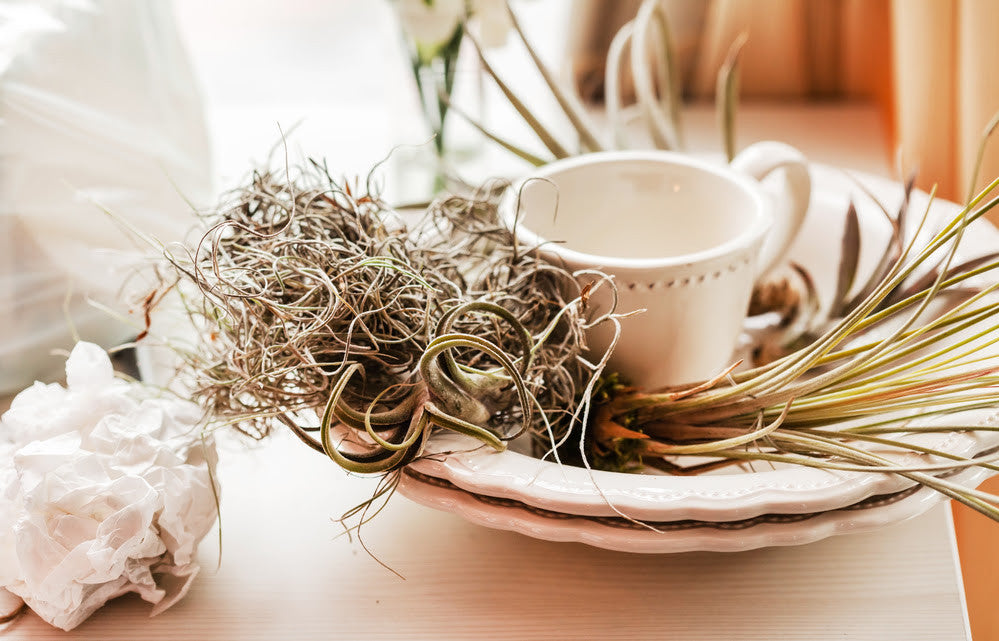How to Grow and Care For Air Plants

Air plants, or Tillandsia, have become incredibly popular for plant enthusiasts and home decorators alike. Their unique growing method, over 650 varieties, and interesting look make them a versatile living decor that can add color and life into your home.
However, since air plants grow differently than other types of house plants, they can be confusing to care for to start out with. Fortunately, Tillandsias are quite hardy, and they require less attention and care than other types of plants, which makes them great if you typically have a “black thumb.”
Air plants are fun to work with, and they are great additions to any plant-lover’s home. Much like other plants, air plants have leaves, roots, and flowers. Unlike other plants, Tillandsias do not need soil to grow. They get all of the nutrients and water that they need to survive from their specialized leaves that are typically strap-shaped or slender and triangle-shaped.
If you’ve traveled warm places like the southern United States, Mexico, or Central and South America, you may have seen air plants attached to rocks, trees, shrubs, and even rooftops and power lines.
Although air plants can grow with very little care, they do still need to eat. Read on to learn how to grow and care for your air plants to ensure they live a long, beautiful life.
Where to Keep Your Air Plant
In an indoor setting, your air plant should receive plenty of natural, bright, and filtered sunlight. While they love warmth, air plants should be protected from full sun exposure. An east, south, or west-facing window would be ideal. If you live in a warmer climate, and outdoor area like a screened-in porch, lanai, or enclosed pool area would be perfect for an air plant.
In cooler areas, make sure your air plant is not somewhere that gets colder than 45 degrees fahrenheit, which can kill the plant.
Watering Your Air Plant
The biggest factor in whether or not you will successfully grow an air plant will likely come down to watering. When kept indoors, owners often under water the plants because they think that the plants will absorb enough moisture from the air. However, this only works in areas with high humidity. Most homes have dryer air due to temperature control, so your air plant will need to be watered.
In an indoor scenario, your air plant will need regular misting and an occasional bath. If your home is shaded or unheated, a mist once or twice a week in the summer, and once a month in the cooler seasons should be enough. Every two weeks or so, you should submerge the plant in water for about three hours.
Misting helps keep the humidity around your air plant up, but it doesn’t ensure that your plant is getting enough water, which is why you need to soak it. Since air plants will only absorb as much water as they need, you don’t need to worry about killing your plant when you do this.
For both misting and soaking your plant, you should use natural rainwater or bottled water. Water that has gone through a water softener is high in salts, so you should avoid this type of water. After soaking your plant, gently shake it upside down to get rid of excess water in the center of the plant.
After submerging your indoor air plant, you may not need to water it again for about 10 to 14 days. Your air plant’s appearance will tell you if it needs to be watered. After you soak it, it should look vibrant and healthy. When it needs to be watered, your plant may look duller, the tips of leaves may be brown, and the leaves can curl under.
Feeding Your Air Plants
Just like other house plants, air plants can be fertilized. Instead of a soil fertilizer, you can use a water-soluble fertilizer that is specific to air plants and mist them with it. These types of fertilizers have nitrogen that can be absorbed by air plants. In the warmer months, you can fertilizer your air plants monthly. Be sure to follow the directions on the package of fertilizer.
Potting Your Air Plant
The beauty of air plants is the fact that they can be housed in a variety of unique containers without the need for soil. This includes glass globes and other unique plant pots like this levitating plant pot. The biggest thing to look for is that the planter allows for plenty of air circulation around your air plant.

When you first get your air plant, soak it for about 30 minutes and allow it to dry almost completely. Then, you can place it in the planter or globe to enjoy in your home.
For more information about air plants, look here.
- Blu Devil
Comments 0